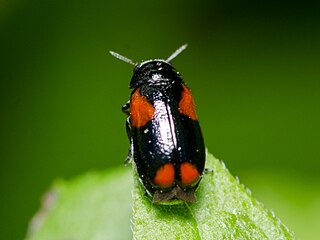
The Donaciinae are a subfamily of the leaf beetles, or Chrysomelidae, characterised by distinctly long antennae. They are found in mainly the Northern Hemisphere, with some species found in the Southern Hemisphere.

Stator is a genus of seed beetles in the family Chrysomelidae. There are about 14 described species in Stator. Most members of the genus specialize on legumes.

Chrysomela is a genus of leaf beetles found almost throughout the world, but not in Australia. It contains around 40 species, including 7 in eastern and northern Europe. It also includes at least 17 species in North America, including the cottonwood leaf beetle Chrysomela scripta.

Oulema is a genus of leaf beetles in the family Chrysomelidae.

Gonioctena is a genus of leaf beetles belonging to the family Chrysomelidae, subfamily Chrysomelinae.

Glyphonyx is a genus of click beetles in the family Elateridae. There are at least 50 described species in Glyphonyx.

Glyptoscelis is a genus of leaf beetles in the subfamily Eumolpinae. There are 38 species of Glyptoscelis described from North, Central and South America. There are also three species of Glyptoscelis known from the West Indies, though they are wrongly placed in the genus. In addition, a single species was described from Hunan, China in 2021.

Smaragdina militaris is a species of case-bearing leaf beetle in the family Chrysomelidae. It is found in North America.
Neofidia texana is a species of leaf beetle that is found in North America. It occurs in central and east-central Texas, and is associated with plants in the grape family (Vitaceae). Neofidia texana was first described as a variety of Fidia viticida by the American entomologist Charles Frederic August Schaeffer in 1934. It is now considered to be a separate species.
Euphrytus is a genus of leaf beetles in the subfamily Eumolpinae. There are 29 described species in Euphrytus from Central and North America, three of which are found north of Mexico.
Cryptocephalus amatus is a species of case-bearing leaf beetle in the family Chrysomelidae. It is found in North America.
Rhabdopterus weisei is a species of leaf beetle. It is found in North America. It was originally described under the name Colaspis subaenea by the American entomologist Charles Frederic August Schaeffer in 1919. However, this name was already used for a species described by Martin Jacoby in 1890, so Schaeffer renamed his species to Colaspis weisei the following year. It was later moved to the genus Rhabdopterus by Herbert Spencer Barber in 1943.
Pachybrachis nigricornis is a species of case-bearing leaf beetle in the family Chrysomelidae. It is found in Central America and North America.
Chrysodinopsis is a genus of leaf beetles in the subfamily Eumolpinae. It was first described by the Czech entomologist Jan Bechyné in 1950. There are three described species in Chrysodinopsis. The genus is possibly synonymous with Brachypnoea.
Cryptocephalus sanguinicollis is a species of case-bearing leaf beetle in the family Chrysomelidae. It is found in Central America and North America.
Colaspis flavocostata is a species of leaf beetle from North America. It is found in the coastal states of the United States; its range spans from Mississippi to Florida and to South Carolina. It was first described by the American entomologist Charles Frederic August Schaeffer in 1933.
Phratora americana is a species of leaf beetle in the family Chrysomelidae. It is found in North America.This species is known from Ontario, Quebec, and high elevations in the eastern United States of America. It feeds on willow species and varies in color from purple to blue or blue-green.

Megalonotus is a genus of dirt-colored seed bugs in the family Rhyparochromidae. There are at least 20 described species in Megalonotus.
Colaspis crinicornis is a species of leaf beetle from North America. It primarily occurs in the Great Plains of the United States. It was first described by the American entomologist Charles Frederic August Schaeffer in 1933. Though it has not historically been considered a pest, population densities of the species have been increasing in corn and soybean over the last decade in southeastern Nebraska. A study has found C. crinicornis to be univoltine in the same region, and that it overwinters in soil as larvae. It has also been found that diets of corn or soybean leaves do not affect the consumption, longevity or fecundity of adult C. crinicornis.
Anomoea flavokansiensis is a species of case-bearing leaf beetle in the family Chrysomelidae. It is found in North America.








